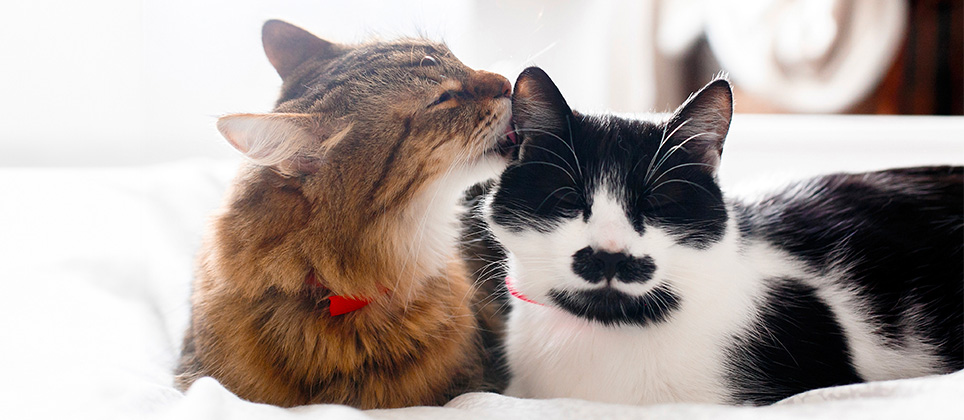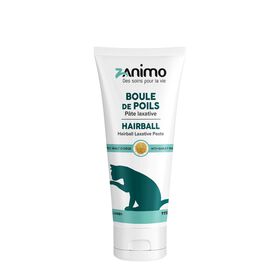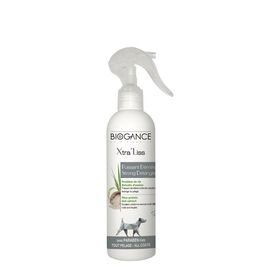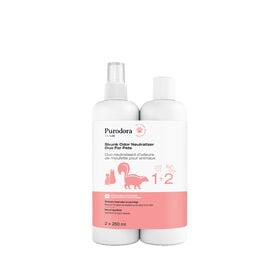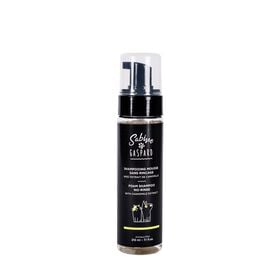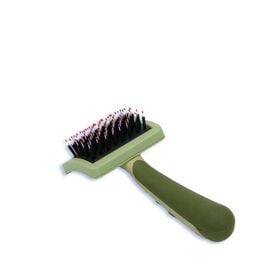Table of Contents
- Why do cats groom themselves?
- How does a cat groom itself?
- Should you bathe your cat?
- What should you do if you need to bathe your cat?
- When should your cat be groomed?
- Where can you get your cat groomed?
- 4 things to consider when choosing a pet groomer
- Cats fighting after a visit to the groomer
- Preventing fights between cats
Should you bathe your cat? If so, how many times a year? How do you wash your cat without risking traumatising them or making them fear water for the rest of their lives? This article explains the basics of cat grooming.
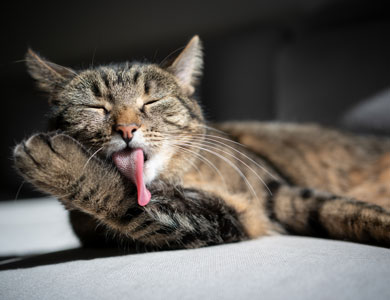
Cats are very clean animals
We all know that cats wash themselves regularly. They spend about 10% to 15% of their time grooming themselves. It's like if you spent between 1.5 and 2 hours in the shower daily!
Some cats clean themselves more than others, but all cats do. If your cat suddenly stops grooming, there may be a health problem. See your vet as soon as possible.
Why do cats groom themselves?
Cats wash for several reasons:
- The primary function is to ensure personal hygiene and maintain a healthy coat and skin.
- Some sources say cats activate their blood circulation by cleaning themselves, which would have several biological benefits.
- The mother washes her kittens to ensure hygiene, stimulate blood circulation and leave the family scent on them.
- Some cats wash each other. This is called allo-grooming. It's generally a sign of good relations. Allo-grooming can also be directed at humans or other pets with whom the cat gets along well.
- A cat may lick a person's hair for pleasure or because the person is using a shampoo containing ingredients that attract them, such as aloe vera, eucalyptus or valerian. Warning: some of these ingredients may be harmful to your cat.
- Some cats lick themselves when uncomfortable, stressed, anxious, in pain or because of allergies. Some will even go so far as to leave no hair on certain parts of their body. This is known as alopecia. If this is the case with your cat, don't delay consulting a vet.
Also read: Why do cats lick themselves as frequently as they do?
How does a cat groom itself?
You may have noticed that a cat's tongue is rough. The little hooks you see on your cat's tongue are about 300 little spoon-shaped bumps of keratin. These bumps help cats wet the base of their hair with saliva. These papillae, at first thought to be conical in shape, have small, curved, hollow tips that act like straws. This ingenious structure enables them to attract and store saliva. This liquid is then transferred to the base of the hairs to clean them effectively.
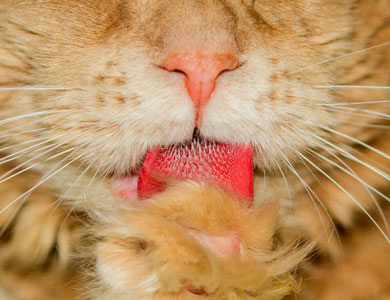
Should you bathe your cat?
The answer is clear: no medical reasons justify bathing a cat. Cats are perfectly capable of washing themselves. The only time it may be necessary to wash a cat is if an accident occurs: if they are sprayed by a skunk, if a product is accidentally poured on them or if their curiosity leads them to stain their fur with food, for example. There are no other exceptions. Bathing a cat is neither required nor recommended unless necessary.
Have you heard that some purebred cats, such as the sphynx, must be washed regularly? There are some nuances to this. As the sphynx has no fur, they require special care to avoid skin problems, but this does not mean the cat must be washed all over. Ask your vet about the appropriate care for this type of cat.
What should you do if you need to bathe your cat?
If an accident happens, the first step is isolating your cat and yourself in the bathroom with the door closed. That way, if they panic, they won't be able to escape to a place where it's difficult for you to reach them. Then, prevent your cat from licking themselves and call your vet to check whether the product coating their fur is harmful to them.
If the affected area is small, wipe it with a damp towel and rub gently to dry. If necessary, use a dry shampoo. This shampoo comes in powder form and should be applied by gently brushing your cat. Warning: it's important to know that most soaps intended for humans are unsuitable for animals. They can irritate their skin or even pose a health hazard.
Pro tip: always keep dry and regular non-scented pet shampoos at home. You'll be happy to have them on hand when you need them. Next time you're in-store, ask one of our specialists to help you choose the right products for your pet.
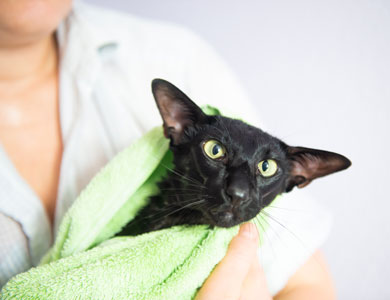
If the area that needs cleaning is large or the product is difficult to remove, and you need to use a lot of water, the last thing you want to do is run a bath and force your cat in. Although some cats enjoy being in the water, many will panic and might hurt you. Instead, use towels soaked in lukewarm water. As much as possible, leave the head and ears dry to avoid infection. Most cats also don't like getting water on their face.
Dry the coat thoroughly by rubbing it gently with dry towels. Make sure you keep the room and your home warm until your cat is completely dry. Don't let your cat go outside that day. Although the surface coat may look dry, the undercoat takes a long time to dry completely, sometimes more than a day.
Getting your cat groomed
It's essential to regularly brush your cat, whether short-haired or long-haired, as brushing removes dead hair and prevents tangles from forming.
Also read: My cat doesn't like to be brushed! What can I do about it?
When should your cat be groomed?
Even with careful care, if knots form in your cat's coat, a visit to a groomer may be necessary. Indeed, these knots can sometimes become painful for cats, as they end up pulling the skin, and can even prevent them from making certain movements.
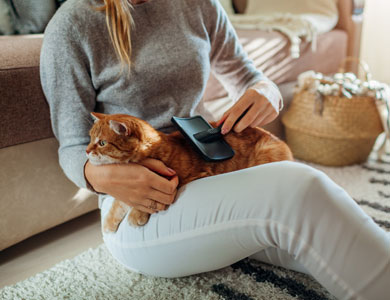
Where can you get your cat groomed?
Grooming is not something you can pick up and do. It takes expertise to do the job properly without hurting or stressing the animal. You should also be aware that the pet grooming industry is not regulated, and anyone can call themselves a pet groomer. So make sure you choose your grooming salon carefully.
At-home grooming services do not unnecessarily stress cats with a car ride. Ethical groomers also offer behavioural grooming services. This approach aims to create a pleasant grooming experience for your pet by adjusting interventions according to their level of well-being. It uses several techniques to manage stress and provides a calm, soothing environment. It even recommends interrupting the session and resuming it on another day if the cat shows too many signs of anxiety or fear.
4 things to consider when choosing a pet groomer
1. Qualifications
Look for qualified groomers who take a respectful and positive approach to pets. Make sure they focus on your cat's well-being, using various skills such as positive reinforcement and behavioural techniques.
2. Integrity
Choose a groomer who aims to establish a long-term relationship with your pet. Make sure they provide an accurate report after each grooming session, demonstrating their willingness to tailor their services to your cat's happiness.
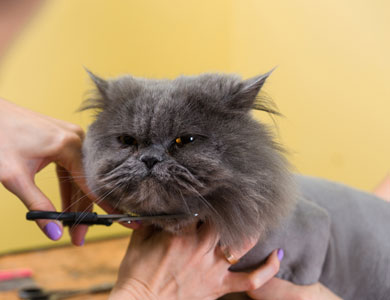
3. Environnement
Choose a place with a quiet grooming area. Look for a place where the bathing and drying areas are separated to reduce noise and measures are taken to minimise the stress of animals being close to each other.
4. Transparency
If it makes you more comfortable, choose a groomer who allows you to be there during the grooming session. You can check your pet's well-being and be reassured about the process.
Cats fighting after a visit to the groomer
One of the most common problems after a cat has been groomed is the aggressive welcome they get from the other cats in the house. Here's why: cats identify each other by smell and appearance. So when a cat returns with no hair, except on their head, paws and the tip of their tail (the infamous pompom), they look nothing like the bushy cat they were before they left home. Moreover, because they've been shaved, they no longer carry their identifying scent, which used to be on their fur. They are, therefore, not recognised by their fellow cats.
Pro tip: ask the groomer not to use the scented powder often used at the end of grooming. It serves no purpose and contributes to the conflict problem.
Also read: What's the best way to properly trim your cat's claws?
Preventing fights between cats
After a visit to the vet or groomer, put your cat in a room with their litter, food and water. Keep your cat away from other cats for about 5 to 7 hours. It will give them a chance to soothe themselves after a stressful experience. They'll also be able to wash themselves thoroughly and put their scent back all over their body, allowing your other cats to identify them even if they have been shaved.
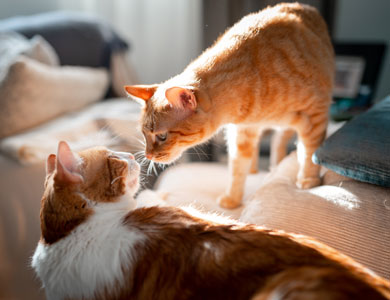
Once the isolation period is over, use this technique to increase your chances of success:
- Give each cat in the house their favourite food or treat. Place the bowls on either side of the door where the groomed cat is. The cats should be able to see each other when you open the door.
- Open the door a few inches while the cats eat. If one of the cats stops eating, stares at the other cat, or tries to approach them, close the door again.
- If they continue eating, slowly open the door and observe their interactions. If they show no signs of stress or aggression, leave them be. If one of the cats starts spitting or growling, get their attention with treats or a toy to distract them. If they become too insistent, return the groomed cat to the containment room and repeat the technique later.
Remember that cats are perfectly capable of grooming themselves without your help. If your intervention becomes necessary, make sure you do things correctly and safely, and keep the stress associated with grooming to a minimum.
